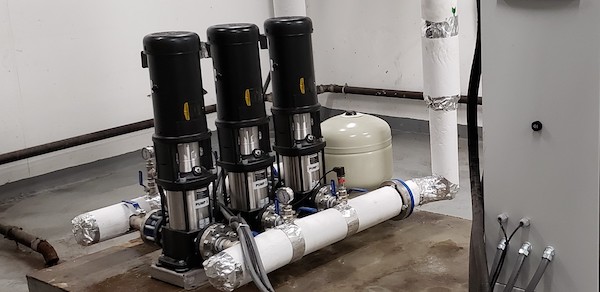
Commercial
Features
Industrial
Institutional
Residential
Audits find hidden savings for pumping systems
Energy costs can be significantly reduced for many high-rise buildings.
August 9, 2019 By Ammar Harastani and Aninda Sarkar
 Photo courtesy Grundfos Canada
Photo courtesy Grundfos Canada As building owners and operators proactively seek ways to save water and energy to reduce their utility bills, an audit can provide the chance to identify hidden opportunities to optimize their facility’s water-pumping systems, with a focus on life-cycle cost analysis and investment payback.
Typically, the initial purchase price of a pump system accounts for about 5% of its entire life cycle costs. Service and maintenance account for approximately 10%. Energy consumption accounts for the remaining 85%—and this is where real savings can be achieved, through a holistic system approach, higher-efficiency motor technology and ‘intelligent’ controls.
Many buildings—including hospitals, condominium towers, office buildings, shopping malls, factories, apartment buildings, universities and colleges—can reduce their pumping systems’ consumption of energy by 30% to 90% following the audit process. The following are some successful examples of verified savings.
CREIT
Before it merged with Choice Properties in 2018, Canadian Real Estate Investment Trust (CREIT) owned, held shares in and managed more than 150 office, industrial and retail properties in cities across the country. Two of these were office towers, located at 175 Bloor Street East in Toronto, that used oversized booster pump systems, each more than 15 years old, running at very low efficiency, experiencing operational issues and requiring hefty maintenance.
Joe De Faria, CREIT’s director of property management, wanted to reassess these systems’ energy efficiency. He turned to Grundfos’ energy optimization team to conduct an eight-day audit, profiling the systems’ flow, pressure and power consumption.
The audit’s collected data showed each tower’s pumping system was operating at a constant speed, with no capability to adjust that speed to match changes in actual demand for water. Further, pressure-reducing valves were being used to regulate fluctuations, which represented a significant waste of energy. In one of the towers, both pumps were on ‘auto.’ In the other, two were completely shut off, while the third was ‘manual.’
Following data analysis, Grundfos recommended the installation of a right-sized integrated pumping system in each of the towers. The south tower’s subsequent annual energy consumption was projected at 8,928 kWh, representing savings of 92% and more than $14,000, with an estimated payback period of three years. The north tower, meanwhile, was projected to consumer 7,457 kWh, saving 96% and more than $25,000 annually, for an estimated payback period of less than two years.
Each building uses a multi-pump controller (MPC) designed for domestic cold water boosting and variable-flow applications in multi-storey buildings. It alternates between lead and lag pumps, ensuring equal running hours for both, and built-in ‘pump curves’ identify when it is more efficient to operate two pumps at a slower speed, rather than one at full speed.
A variable-frequency drive (VFD) in the MPC reduces speed to match flow demand, allowing the pumps to continuously regulate speed while maintain predetermined, constant pressure. As the pumps only run when demand is detected, their useful life is extended and their energy consumption and maintenance costs are reduced. A control panel supports communications with each building’s automation system.
Northern Air Environmental Technologies completed the south tower’s MPC installation in February 2017 and the north tower’s two months later. They qualified CREIT for an incentive rebate from Toronto Hydro, the local electrical utility, for $27,026.
Del Property Management
Since 1968, Del Property Management—part of the Tridel group of companies—has provided services to condominium buildings. And since 1984, those buildings have included many built by developers other than Tridel itself.
Several years ago, a Del client operating a 54-storey condo tower in Toronto found the building’s 12-year-old booster pump system was experiencing operational and maintenance issues.
“The system design was very inefficient,” says Bernie Baskovic, vice-president (VP) and district manager for Del.
Grundfos’ energy optimization team undertook a pump audit, evaluating the existing system and determining the savings potential of a replacement project.
The audit revealed the existing system was oversized. Its three pumps were operating in constant-speed mode, incapable of varying with changes in the building’s water demand. And again, valves were being used to regulate fluctuations in pressure, wasting significant energy.
Grundfos recommended an MPC with three centrifugal, vertical, in-line, multi-stage pumps with 20-hp motors and VFDs. Its projected annual energy consumption of 42,203 kWh represented savings of 85% and more than $29,000, with an estimated payback period of just over one year. The upgrade also earned an incentive rebate of $29,000 from Toronto Hydro.
Overall, Del has retrofitted close to 100 buildings to date, saving its clients more than $1 million on electricity costs and through rebates.
Ammar Harastani and Aninda Sarkar are energy optimization sales managers for pump manufacturer Grundfos, which has completed more than 500 audits within Canada, covering different pump sizes and applications. For more information, visit ca.grundfos.com.
This article originally appeared in the July 2019 issue of Energy Manager Canada magazine.
Print this page